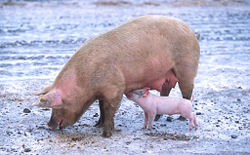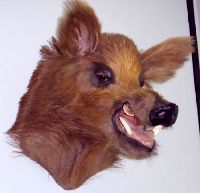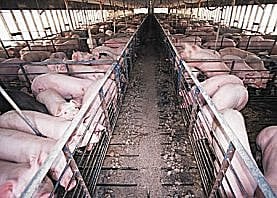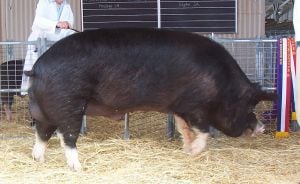Pig
| Pig | ||||||||||||
|---|---|---|---|---|---|---|---|---|---|---|---|---|
 Domestic sow with piglet | ||||||||||||
| Scientific classification | ||||||||||||
| ||||||||||||
| Species | ||||||||||||
|
Sus ahoenobarbus Palawan bearded pig
Sus verrucosus Javan warty pig |
Pigs are members of the genus Sus, within the Suidae family. They are even-toed ungulates, hoofed mammals, native to Eurasia and Africa. Pigs, in the wild, live mostly in forests and savannas and play an important role in nature. The domestic pig, Sus scrofa domestica, was one of the first animals domesticated by humans and is still today one of the most important domestic animals.
Description and behaviour
Description and behavior
Pigs are one of the most widespread and successful genera of large mammals. They are found wild over most of Eurasia from tropical jungles to northern forests. There are 10 species of living pigs and many subspecies. The Pigmy hog of India, Sus salvanius, is about 20 to 30 cm (8 to 12 in) high at the shoulder and weighs 7 to 12 kg (15 to 26 lbs) while the Eurasian wild pig, Suc scrofa, can be from 55 to 110 cm (1.8 to 3.6 ft) high at the shoulder and weigh from 44 to 320 kg (91 to 711 lb) (Huffman 2006).
Unlike most other hoofed mammals pigs do not have multi-chambered ruminating stomachs and can not survive on leaves and grasses alone. Instead they are omnivores, which means that they consume both plants and animals. They eat a wide variety of foods including acorns and other seeds, roots, tubers, fungi, fruit, carrion, eggs, insects, and small animals - snakes being a favorite.
Pigs are very intelligent, therefore, they are highly trainable animals, and some, such as the Asian pot-bellied pig, are kept as pets. A litter of piglets typically contains between 6 and 12 animals. Occasionally, in captivity, pigs may eat their own young.
Pigs do not have effective sweat glands [1], so pigs cool themselves using water or mud during hot weather. They also use mud as a form of sunscreen to protect their skin from sunburn. Mud also provides protection against flies and parasites.
Pigs are very intelligent, therefore, they are highly trainable animals, and some, such as the Asian pot-bellied pig, are kept as pets. A litter of piglets typically contains between 6 and 12 animals. Occasionally, in captivity, pigs may eat their own young.
Pigs do not have effective sweat glands [2], so pigs cool themselves using water or mud during hot weather. They also use mud as a form of sunscreen to protect their skin from sunburn. Mud also provides protection against flies and parasites.
Pig species
- Sus barbatus Bearded Pig; Malaysia, Indonesia
- Sus bucculentus Vietnamese Warty Pig
- Sus cebifrons Visayas Warty Pig
- Sus celebensis Celebes Warty Pig
- Sus daelius Poulter Warty Pig
- Sus heureni Flores Warty Pig
- Sus philippensis Philippine Warty Pig
- Sus salvanius Pigmy Hog; NE India, Himalayas
- Sus scrofa (also called S. domesticus) Domestic pig, razorback, wild boar; Europe, Asia
- Sus timoriensis Timor Warty Pig
- Sus verrucosus Javan pig, Warty Pig; Indonesia, Philippines
- Sus habeoncosus Malaysian pig, Warty Pig
Hybrid swine
Domestic Tamworth Pigs are often crossed with wild boar to create "Iron Age Pigs" that resemble early domestic pigs. The piglets have stripes or blotches like young boar. "Iron Age Pigs" are a common attraction at farm parks. The hybrids are tamer than wild boar, but less tractable than domestic swine and generally become specialist pork sausages. Other domestic breeds of pig have been crossed with wild boar to produce a leaner meat for the specialist meat trade.
Various domestic pigs have been crossed with American wild hogs to produce compact, hairy hog-like hybrids.
In "The Variation Of Animals And Plants Under Domestication" Charles Darwin wrote: The European wild boar and the Chinese domesticated pig are almost certainly specifically distinct: Sir F. Darwin crossed a sow of the latter breed with a wild Alpine boar which had become extremely tame, but the young, though having half-domesticated blood in their veins, were "extremely wild in confinement", and would not eat swill like common English pigs.
Domestic pig
The domestic pig (Sus scrofa domesticus) is usually given the scientific name Sus scrofa, though some authors call it S. domesticus, reserving S. scrofa for the wild boar. It was domesticated approximately 5,000 to 7,000 years ago. Pigs are found across Europe, the Middle East and extend into Asia as far as Indonesia and Japan. The distinction between wild and domestic animals is slight, and domestic pigs have become feral in many parts of the world (for example, New Zealand) and caused substantial environmental damage.
Sus scrofa has four subspecies, each occupying distinct geographical areas:
- Sus scrofa scrofa (western Africa, Europe)
- Sus scrofa ussuricus (northern Asia and Japan)
- Sus scrofa cristatus (Asia Minor, India)
- Sus scrofa vittatus (Indonesia)
Pigs are one of the oldest forms of livestock, having been domesticated as early as 5000 B.C.E. [3]. It is believed to have been domesticated either in the Near East or in China from the Wild Boar. The adaptable nature and omnivorous diet of the Wild Boar allowed early humans to domesticate it much earlier than many other forms of livestock, such as cattle. Pigs were mostly used for food, but people also used their hide for shields, their bones for tools and weapons, and their bristles for brushes. Pigs were brought to southeastern North America from Europe by De Soto and other early Spanish explorers. Escaped pigs became feral and were freely used by Native Americans as food.
As food
The domestic pig is farmed for its meat called pork. Products made of pork include sausage, bacon and ham. The head of a pig can be used to make head cheese. Liver, chitterlings, and other offal from pigs are also widely used for food.
In some religions, such as Judaism and Islam, there are religious restrictions on the consumption of pork.
In industrialized nations, domestic pigs farming has shifted away from the traditional pig farm to large-scale intensive pig farms where meat can be mass-produced. This has resulted in lower production costs, but more significant animal welfare concerns.
In developing nations, and some parts of developed nations, the domestic pig is frequently raised outdoors in yards. In some cases pigs are even raised in open fields where they are allowed to forage; they are watched by swineherds, essentially shepherds for pigs.
In 2005, the global stocks of pigs showed China with 488.8 millino head of domestic pigs, followed by the United States with 60.4 million head, Brazil with 33.2 million head, Vietnam with 27 million head, Germany wiht 26.9 million head, and Spai with 25.3 million head.
As pets
Pigs are known to be intelligent animals and have been found to be more trainable than dogs or cats. Asian pot-bellied pigs, a smaller subspecies of the domestic pig, have made popular house pets in the United States beginning in the latter half of the 20th century. Regular domestic farmyard pigs have also been known to be kept indoors, but due to their large size and destructive tendencies, they typically need to be moved into an outdoor pen as they grow older. Most pigs also have an extreme fear of being picked up, but will usually calm down once placed back on the floor.
Breeds of pigs
Pigs are exhibited at agricultural shows, judged either as stud stock compared to the standard features of each breed, or in commercial classes where the animals are judged primarily on their suitability for slaughter to provide premium meat.
Linguistics
Etymology
Modern English "pig" probably derives from Old English "*picg", which was found within compound words, the ultimate origin is unknown but Dutch "big" (meaning "young pig") seems to be a cognate. Originally "pig" referred to young pigs only as the word for adults was swine. Another Old English word for "pig" was "fearh", related to "furrow" from the Proto-Indo-European stem "*perk" meaning "dig, furrow" (compare Latin "porcus" meaning "pig") . This reflects a widespread Indo-European tendency to name animals from typical attributes or activities. A young pig which has just weaned is called a shoat
- The noise that a pig makes is usually represented as "oink" in the English language but in many different ways in other languages – for instance, chrum (Polish), hunk (Albanian), hulu (Mandarin Chinese), nøff (Norwegian) and so on. See oink for a fuller list.
- A young pig which has just weaned is called a shoat
- Early footballs were originally made from animal bladders, often from pigs. This was the origin of the term pigskins.
- The familiar piggybank got its name and shape as a result of a pun on the word pygg, a type of clay commonly used to produce household items in the 18th Century.
- Pig iron is so named because the molten newly-smelted iron was once poured into molds resembling rows of suckling pigs.
- A type of barrel called a "hog's head" appears often in the writings of Mark Twain.
- A "hogshead" is a large volume of liquid. The term is also a colloquial reference to the gearbox for the "drive" wheels of automobiles, especially for large transport trucks, particularly those used in the Pulpwood industry of the Southeastern United States.
Cultural references to pigs
As an animal living closely with the people, pigs were and are frequently referenced in human culture.
Pigs in religion
- In ancient Greece, a sow was an appropriate sacrifice to Demeter and had been her favorite animal since she had been the Great Goddess of archaic times. Initiates at the Eleusinian Mysteries began by sacrificing a pig.
- The pig is one of the 12-year cycle of animals which appear in the Chinese zodiac related to the Chinese calendar. Believers in Chinese astrology associate each animal with certain personality traits. See: Pig (Zodiac).
- The dietary laws of Judaism (Kashrut, adj. Kosher) and Islam (Halal) forbid the eating of flesh of swine or pork in any form, considering the pig to be an unclean animal (see taboo food and drink).
Environmental impacts
Accidental or deliberate releases of pigs into countries or environments where they are an alien species have caused extensive environmental damage. Their omnivorous diet, aggressive behaviour and their feeding method of rooting in the ground all combine to severely damage ecosystems unused to pigs. Pigs will even eat small animals and destroy nests of ground nesting birds. [4]
Health issues
Pigs harbour a range of parasites and diseases that can be easily transmitted to man. These include trichinosis, cysticercosis, and brucellosis. They also very commonly have large concentrations of parasitic ascarid worms in their guts. The presence of these diseases and parasites is one of the main reasons why pork meat should always be well cooked or cured before eating. Pigs can also be aggressive and pig induced injuries are relatively common in areas where pigs are reared of where they form part of the wild or feral fauna.
ReferencesISBN links support NWE through referral fees
- Food and Agriculture Organization of the United Nations (FAO). 2006. FAOStat Website. [5]
- Huffman, B. 2006. The Ultimate Ungulate Page Website [6]
- Invasive Species Specialist Group (ISSG). 2006. "Global Invasive Species Database: Sus scrofa" [7]
- Klober, Kelly. 1997 A Guide to Raising Pigs. Pownal, Vermont : Storey Publishing ISBN 1580170110
- Moore, J.R. 2001. "Swine production: a global perspective" [8]
- National Pork Board (NPB). 2006 The Daily Pork Website [9]
- Nowak, R. M. and J. L. Paradiso. 1983. Walker's Mammals of the World. Baltimore, Maryland: The Johns Hopkins University Press. ISBN 0801825253
- Oklahoma State University (OSU). 2006 Breeds of Livestock: Swine[10]
- University of California Museum of Paleontology (UCMP) 2006. Ungulates: Hoofed Mammals
- Voelker, W. 1986. The Natural History of Living Mammals. Medford, New Jersey: Plexus Publishing, Inc. ISBN 0937548081
- Watson, Lydall. 2004 The Whole Hog. New York : Smithsonian Books ISBN 1588342166
External links
- National Pork Board's Children's Page
- Alberta Pork informational page (PDF)
- Swine Breeds, with pictures
- Managing pig health
- Information on over 130 pig diseases
- Pig Disease identification software tool
- Lots of piggy photos
Credits
New World Encyclopedia writers and editors rewrote and completed the Wikipedia article in accordance with New World Encyclopedia standards. This article abides by terms of the Creative Commons CC-by-sa 3.0 License (CC-by-sa), which may be used and disseminated with proper attribution. Credit is due under the terms of this license that can reference both the New World Encyclopedia contributors and the selfless volunteer contributors of the Wikimedia Foundation. To cite this article click here for a list of acceptable citing formats.The history of earlier contributions by wikipedians is accessible to researchers here:
The history of this article since it was imported to New World Encyclopedia:
Note: Some restrictions may apply to use of individual images which are separately licensed.




